|
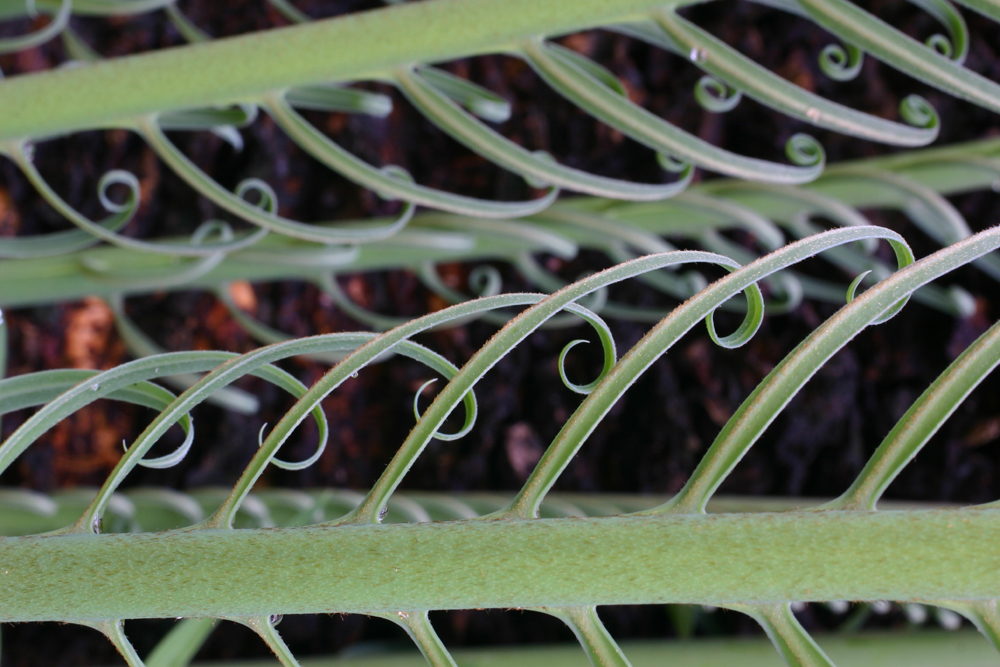
Emergent
Cycas thouarsii leaf
December 4, 2009
The
Villagers Holiday House Tour brings nearly 700 visitors to MBC
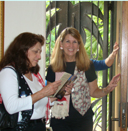 Annually,
The Villagers pick a handful of houses to showcase on their Holiday
House Tour. This year, Nell’s House and the Arthur Montgomery
Guesthouse were chosen to participate. The
Villagers organized
the event, which allowed nearly 700 visitors to tour six homes “Down
Old Cutler Way.” Annually,
The Villagers pick a handful of houses to showcase on their Holiday
House Tour. This year, Nell’s House and the Arthur Montgomery
Guesthouse were chosen to participate. The
Villagers organized
the event, which allowed nearly 700 visitors to tour six homes “Down
Old Cutler Way.”
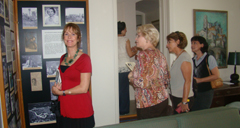
The Villagers is an organization dedicated to the
restoration and
preservation of historic sites. They have supported numerous
projects here at Montgomery Botanical Center. The most recent
project supported the restoration of the Arthur Montgomery Guesthouse.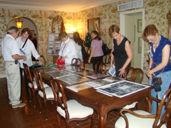
Montgomery Botanical Center distributed an
information
sheet about
MBC to all visitors on the Holiday House
Tour. Included in
the document were interesting facts about MBC’s history
and two
Christmas Cards from the 1940s that Colonel Montgomery and Nell
Montgomery sent to their friends.
"Being on The Villagers tour
exposed Montgomery Botanical Center to many local residents who
previously had no knowledge of our organization. We are very grateful
for The Villagers continued support,” said Outreach Manager Tracy
Magellan.
November 14, 2009
Montgomery
Botanical Center hosts 50th Anniversary Conference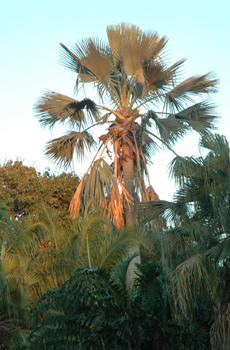
Our 50th year is a good time to look
back and also forward. Both ways, we see the mission solidly
met. Research, conservation, and education flourish through
living botanical collections.
Nine
speakers from around the world came together to present lectures on a
variety of topics from the history of Montgomery Botanical Center, to
specific research conducted using Montgomery Botanical Center's living
collection.
The
speakers were: Angelica Cibrian, John Dransfield, Javier
Francisco-Ortega, Patrick Griffith, Walter D. Haynes, Carl Lewis, Lloyd
Singleton, Dennis Stevenson, and Barry Tomlinson. Each speaker
had a personal story to tell about Montgomery Botanical Center and its
living collection.
Pictures
from the event can be found in the 50th
Anniversary Conference Report.
Please
join us in celebrating our 50th anniversary year!
November 3-5, 2009
Montgomery Botanical Center Hosts 6th
International BMAA Conference
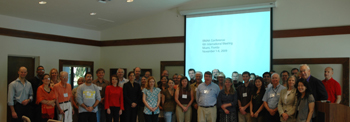 Montgomery Botanical Center continues its support of
research by hosting the 6th International BMAA Conference in the Nixon
Smiley Building for three days. 45 scientists from 18
institutions around the world attended the conference. The
countries included were the United States, Sweden, France, Scotland,
Australia, South Africa, the Netherlands, and England. Montgomery Botanical Center continues its support of
research by hosting the 6th International BMAA Conference in the Nixon
Smiley Building for three days. 45 scientists from 18
institutions around the world attended the conference. The
countries included were the United States, Sweden, France, Scotland,
Australia, South Africa, the Netherlands, and England.
BMAA is a cyanobacterial neurotoxin that has been found in the brains
of those who suffer from ALS and Alzheimer’s disease.
Montgomery Botanical Center has been involved in BMAA research through
its cycad collection for years. Cycas
micronesica is an interesting species studied due to the high
incidence of ALS in Guam and the potential correlation or association
between the BMAA in Cycas micronesica
and ALS. Conserving rare species like Cycas micronesica is important for
botanists and medical researchers alike.
Dr. Paul Cox stated, “The Nixon Smiley meeting room was perfect for our
conference. The audio/visual system functioned perfectly, and the
kitchen and terrace overlooking the pond were fantastic for our
lunches.”
Montgomery Botanical Center was happy to host BMAA scientists at the
Arthur Montgomery Guesthouse as part of its ongoing support of
research.
November 2009
Fall/Winter 2009 Montgomery Botanical News
is Now Online!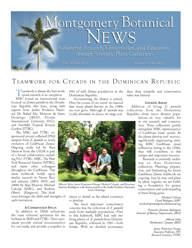
This
new
issue has articles on scientific collaboration, fieldwork in
Belize, new additions to our collection, natural disaster planning, and
updates on current research.
Montgomery
Botanical Center publishes two newsletters a year to keep our
supporters and collaborators up to date and informed. To read
more about how Montgomery Botanical Center meets our mission of
"Advancing Research, Conservation, and Education through Scientific
Plant Collections" you can access our newsletters online.
To
access PDFs of past newsletters please go to the Newsletters
button on the left or click the
hyperlink.
October 24, 2009
UPS Global Volunteer Month
Workday at MBC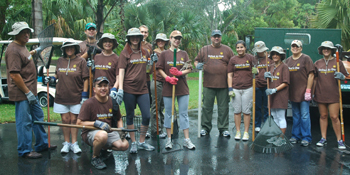
Twenty-two UPS employees came to Montgomery Botanical Center to participate in
an environmental volunteer day. Montgomery Botanical is committed to
sustainable practices. On aspect of this commitment
is seen in MBC’s Plant Recycling Operation. Trees trimmed
on the property are recycled into mulch.
Mulching has many benefits: it recycles nutrients, it prevents weed 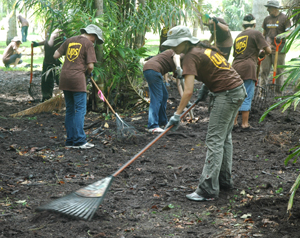 invasion, and it serves as a shelter for
large predatory insects–that in turn eat pest insects. Using mulch also
minimizes the need for the use of fertilizer or herbicide. invasion, and it serves as a shelter for
large predatory insects–that in turn eat pest insects. Using mulch also
minimizes the need for the use of fertilizer or herbicide.
Laurie Danielson, Palm Curator, is very pleased with
the good work done. Montgomery Botanical Center is thankful to all the
UPS volunteers, who worked so hard and did so much.
Dr. Patrick Griffith states, “There are two things I’ll remember about
this group: number one–excellent positive attitudes and team spirit,
number two–strong backs. The UPS volunteer team put us ahead by 3
weeks.”
October 6, 2009
Large-scale study illuminates evolution of
the Coconut Palm
Dr.
Alan Meerow and his colleagues have
published an extensive study
of palm relationships focusing on the Coconut Palm, Cocos nucifera, and its relatives.
The study appears in the latest issue of PLoS One, a prestigious,
broad-based, open-access science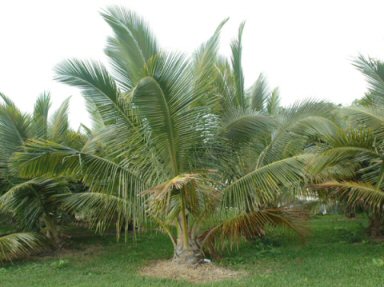 journal.
journal.
The
Coconut is one of the world's most economically
important plant species. The origin of the Coconut, and its
relationship to other palm species, are long-standing mysteries for
botanists. Much previous work has been focused on these questions, with
a variety of hypotheses. Dr. Meerow's work uses a very large DNA data
set, which strongly supports a very close relationship between Cocos nucifera and the genus Syagrus. The study found that that
Coconut Palm diverged from Syagrus around
35 million years ago.
Especially
since 1992, MBC has been actively developing a strong collection of Syagrus and its relatives, and
these living plants were used to provide DNA for the investigation. Dr.
Larry Noblick, MBC Palm Biologist, is one of the co-authors on the
recent work.
Dr.
Meerow is the Research Geneticist and Systematist at Chapman Field.
From 2006 forward, The MBC Board of
Directors has recognized Dr. Meerow as an Honorary Member for his
frequent collaboration and assistance with MBC’s botanical research and
horticulture. Alan's participation in joint expeditions with MBC, his
advice and consultation, and his coauthorship are of great value to
Montgomery. This ongoing collaboration has its roots in the
colleagueship of Col. Robert Montgomery and Dr. David Fairchild, and
the plant collections they founded at MBC and Chapman Field.
September 25, 2009
New Palm Species described by Dr. Larry
Noblick, MBC Palm Biologist
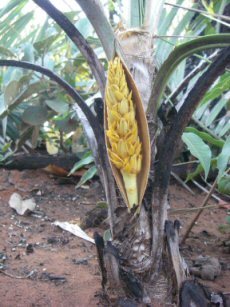
A new species, Syagrus evansiana,
was described in the latest issue of Palms,
the journal of the International Palm
Society. Dr. Larry Noblick, MBC Palm Biologist, named this species
in honor of Don Evans, an experienced horticulturist, who originally
brought this discovery to Larry's attention.
Syagrus evanisiana is a
nearly-stemless, diminutive palm, which is found in rocky open fields
in Minas Gerais, Brazil. This part of the world has seasonal fires, and
trees there often have thick, corky bark as protection. In Syagrus evansiana, the stemless
habit keeps the palm's heart safely underground as fire passes over;
the crown of leaves may burn off, but can be regrown.
Dr.
Noblick has worked extensively in the genus Syagrus and its relatives Butia, Lytocaryum, and Attalea. Larry's work has
discovered many new species, often using the living collections at
Montgomery.
September 18, 2009
Dr. John Dowe Lectures on Rattans at MBC
Dr.
John Dowe gave a lecture at the Nixon Smiley Building on his 20 years of
research on
Australian palms. The talk was Dr. Dowe's fifth lecture at Montgomery
Botanical Center. Dr. Dowe is a Montgomery
Botanical Research
Fellow who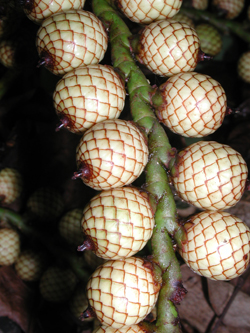 conducts research annually at MBC. Dr.
Dowe has published work with Dr. Larry Noblick, MBC Palm
Biologist. conducts research annually at MBC. Dr.
Dowe has published work with Dr. Larry Noblick, MBC Palm
Biologist.
Dr. Dowe’s lecture focused on the rattan palms, Calamus. Rattan palms are
dioecious (separate male and female trees) and they have a whip like
flagellum that allows them to grab onto trees to climb into the canopy.
All of the parts of the rattan are spiny except for the stems. The
stems have historically been and are currently used for
furniture.
Dr. Dowe told a story about the evolution of the common name of the
rattan palm from the Lawyer Vine to the Wait-a-While. The vines were
originally viewed as fierce, but now are revered as a symbol of a
relaxed way of life.
Dr. Dowe’s book on Australian palms will be published next year. It
will contain 320 pages and detail 60 species of Australian palms.
Montgomery Botanical Center will make the botanical data from this book
available on the MBC website. The work of Dr. Dowe helps advance MBC’s
mission of palm research.
September
8, 2009
Montgomery Botanical Center Featured in The
Miami Herald
On
Tuesday, Montgomery Botanical
Center was featured in a story
in the Local and State section
of The Miami Herald titled,
“Coral
Gables research garden hosts ancient plants.” Herald author Laura
Morales wrote a nice article about Montgomery and the plant
collections.
The article focused on MBC plant collections. Quoting the article,
“More than 1,000 plant species—including more than 620 species of
cycads and palms, the center’s two specialties—thrive on Montgomery’s
120 acres at 11901 Old Cutler Road. The American Public Gardens
Association has accredited the center's holdings as Collections of
National Significance.” These large
collections have great conservation significance. Some species in the
collection no longer exist in the wild, making the few that are
conserved here very important.
The article also discusses current and future plans for increased
capacity and support of
the MBC mission.
To see the full article
click
here.
August 20, 2009
Longwood Graduate Program Blogs About MBC
The
Longwood Gardens Graduate Program came to Montgomery Botanical Center
for a foot tour of the collection. Despite the Summer heat, they
wrote up a wonderful blog entry about the collection here at MBC.
To see their post click here.
August
10, 2009
The
University of Miami School of Law’s HOPE Students Help at MBC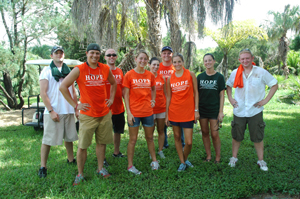
Nine
student volunteers from the University
of Miami' s Helping
Others Through Pro Bono Efforts (HOPE) came to
Montgomery Botanical
Center and helped with a large-scale mulching project. They mulched all
of the tropical conifer beds in three hours! Having nine extra
hands to help with the project saved MBC days of work.
Montgomery Botanical Center has a growing tropical conifer collection
with many extremely rare species. Mulching ameliorates the soil
microclimate, provides habitat for beneficial insects, and slowly
releases nutrients for the plants.
Montgomery Botanical Center is very thankful to all the students who
helped out. The University of Miami School of Law’s HOPE Public
Interest Resource Center sent hundreds of law students to approximately
20 sites across Miami-Dade County through the Annual HOPE
Day of Service. MBC is glad to have been one of the 20
participating institutions.
August
2009
A
Look Back at MBC’s Ongoing Contribution to Science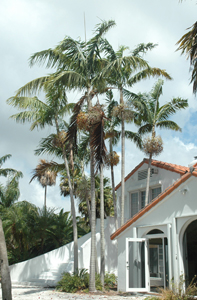
Montgomery
Botanical Center is dedicated to living plant collections, grown to advance
botanical research, conservation, and education. 2009 marks the 50th
anniversary of MBC.
Looking back, it is easily apparent that the living plant collections
at MBC have contributed to many studies since 1959. Even before the
founding of MBC, Colonel Montgomery’s plant collections contributed to
the work of botanists from very early on.
As part of this year's recognition of MBC history, the team compiled a bibliography
of works that utilized
the living collections, going back to The Colonel’s era -- over 200
published works in botany have been helped by the living plant
collections here. Well over half of these works are from the last ten
years, evidence of the increased importance of living plant collections.
One early example is the description of Veitchia montgomeryana by
H. E. Moore, from living material grown by Colonel Montgomery.
This scientific paper from 1957 honored Colonel Robert H. Montgomery
"whose name so richly deserves to be associated with a member of the
[Palm] family."
In recent years, MBC has seen increasing volume of works in diverse
fields, including biodiversity, physiology, taxonomy, developmental
biology, and also significant use of the collections for popular and
educational materials.
July
25, 2009
New
Species of Cycads described by MBC Cycad Biologist, Michael Calonje
Michael
Calonje and his colleagues have described two new species of Zamia in Belize, and worked to
clarify another species. Three new research papers appeared in the
current issue of Journal
of the Botanical Research Institute of Texas, which has generously
made these works available on BRIT website.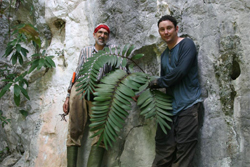
Michael was alerted to an interesting cliff-dwelling Zamia species by Jan Meerman,
a well-known Belizean ecologist, last year. Since Jan’s
careful
fieldwork first discovered this new cycad, Michael honored
Jan by naming this species Zamia
meermanii.
Another
new description names a cycad which has been very little studied. Zamia decumbens is a critically
endangered species with a very unique ecology, growing only at the
bottom of sinkholes or on rocky mountain tops. In recent years, these
plants have mistakenly been called Z.
prasina in horticulture and botany.
So, then, what
is Zamia prasina?
Collaborative research by Michael and Jan determined that Zamia prasina is actually the
correct name for a widespread, common cycad species known from
Belize, Guatemala, and the Yucatan peninsula in Mexico.
MBC is especially grateful for a conservation grant by the Association of Zoological Horticulture.
This grant funded the conservation
fieldwork which led to these discoveries.
MBC
at APGA 2009
Montgomery
Botanical Center participated in the 2009 American Public Gardens
Association conference, held in St. Louis. Dr. Patrick Griffith
presented two talks on MBC living collections management, and moderated
a session on Conservation and Research at botanic gardens.
The first MBC talk highlighted the role of geographic analysis in
collections development. Dr. Michael Dosmann of the Arnold Arboretum
organized the session, focusing on new directions in collections
management. Working with MBC Cycad Biologist Michael Calonje, Patrick
presented examples of how organizing collections information on maps
leads to efficient planning, effective conservation -- and even new
botanical discoveries.
The second MBC talk was part of a session organized by Dr. Andrea
Kramer of BGCI, which considered
the conservation value of living plant collections. Recent collaborative
research between MBC, Florida
International University, and Fairchild Tropical Botanic
Garden is designed to address this question. Patrick presented the
results of these studies, along with new cost models designed to
optimize the effectiveness of ex situ conservation investment by
botanic gardens.
June
13, 2009
Volunteer Tree
Planting Day and Dedication
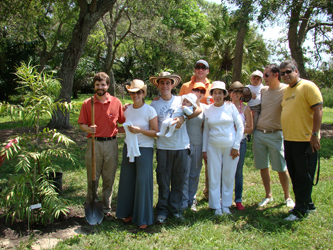 Montgomery Botanical Center would like to thank the
Cardona-Tessy family for supporting a tropical conifer tree planting
day. Montgomery Botanical Center would like to thank the
Cardona-Tessy family for supporting a tropical conifer tree planting
day.
Paul Tessy and Genita Beatriz Cardona, along with six friends, helped
MBC plant nine trees. The trees were wild collected and raised in our
nursery until this year’s planting season. Some of the species planted
were: Agathis macrophylla, Agathis corbassonii, Podocarpus elongatus 'Blue Chip', Podocarpus guatemalensis, Podocarpus neriifolius, Podocarpus polystachyus, and Podocarpus trinitensis.
The last tree planted, Agathis moorei,
was dedicated in honor of the birth of their first child, Martin Joseph
Tessy. The Tessy family is passionate about environmental
sustainability, and wanted to support conservation here at MBC. MBC
thanks the Tessy family and their friends for their support; the trees
are looking wonderful!
June 4, 2009
Jackie Bergquist
Presents Research on
Managing Miami's Botanical Collections through Hurricanes.
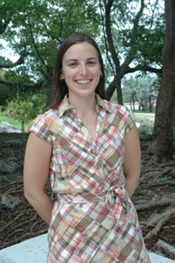 Jackie Bergquist, from the Longwood Graduate
Fellows program at the University of Delaware, gave a public
seminar at
MBC on June 4, titled, "The Development of a Natural Disaster Planning
Template for use in Plant Collections Management." Jackie Bergquist, from the Longwood Graduate
Fellows program at the University of Delaware, gave a public
seminar at
MBC on June 4, titled, "The Development of a Natural Disaster Planning
Template for use in Plant Collections Management."
Last summer, Ms. Bergquist was hosted at the Arthur Montgomery
Guesthouse while conducting on-site research on living collections
management at five local gardens--Montgomery Botanical Center, The
Kampong, Fairchild Tropical Botanic Garden, Viscaya, and the Gifford
Arboretum. Ms. Bergquist's innovative work was partially supported by
the Montgomery Botanical Research Fellows program, through the generous
support of the Kelly Foundation.
Ms. Bergquist's thesis examined the natural disaster planning process
in public gardens, in order to identify the details that make a natural
disaster plan truly useful to an organization. The research
conducted included two national public garden surveys, three on-site
case studies, and nine on-site interviews with botanical institutions
that had experienced disaster.
While many Botanic Gardens have disaster plans, only one in five has a
recovery plan that is specifically focused on living collections. Ms.
Bergquist's work aims to make living collections recovery a central
focus of the disaster planning process.
The staff at Montgomery Botanical Center are happy to have contributed
to such an important study. Being located in South Florida, MBC
can experience tropical storms and hurricanes;
thoughtful planning and preparation goes a great distance in managing
living collections through these natural disasters.
June 1, 2009
Montgomery Botanical Center receives CAP grant to assess
Living Collections
and Historic Structures.
The
Institute of
Museum and Library Services (IMLS) and Heritage Preservation
collaboratively support Montgomery Botanical Center through the Conservation
Assessment Program (CAP). Montgomery Botanical Center was one
of 100 museums in 39 states to receive this prestigious award.
The CAP award will provide an assessment of our living collection and
our historic structures. This expert assessment will allow MBC to
plan for future needs to support the living collections at the core of
our mission.
May 19, 2009
Dr.
Josiane Le Corff presents research on Horticulture Ecology
Dr.
Le Corff, an ecologist from the French
Institut National d’Horticulture, AGROCAMPUS-OUEST is being hosted
in the Arthur Montgomery Guesthouse while researching with MBC Honorary
Member Dr.
Carol Horvitz from the University of Miami. France is working on
“grenelle de
l’environnement”-“greening the environment” and part of the program is
decreasing pesticide use by 50%. In France less than 2% of crops are
grown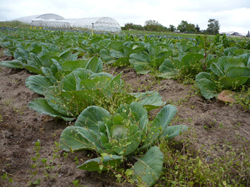 organically. France is also the largest user of
pesticides in
all of Europe. organically. France is also the largest user of
pesticides in
all of Europe.
To
meet the goal of lowering pesticide use, the French are trying to
promote natural enemies of plant pests. From previous work on
conservation biological control, it
has been shown that landscapes with hedgerows, fallows, and
weeds usually harbor a higher density and diversity of natural
enemies compared to areas dominated by arable land. Predatory
insects appear to be attracted to both host weeds and crops in the
Brassicaceae.
Dr.
Le Corff’s innovative work studies the effects of weeds amongst crops
in attracting more predatory insects into the crop ecosystem. This
planting system can perhaps alleviate the pressure that pest insects
place on the crop plant. Dr. Le Corff presented her findings at the
Nixon Smiley Meeting Room to a large audience made up of individuals
from the University of Miami, Florida International University, Miami
Dade College, The Kampong, the USDA, and Jungle Island.
May 18, 2009
Montgomery
Botanical Center celebrates Plant Conservation Day.
Every year Montgomery Botanical
Center conducts multiple expeditions
to bring endangered plants into protective cultivation. In the
last year, MBC has performed conservation fieldwork in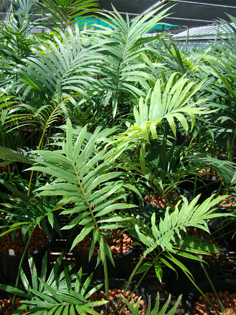 Belize,
Jamaica,
Panama, Colombia, and New Zealand. Please see the Expeditions
page on our website for
detailed accounts of our collecting trips and ex situ conservation work. Belize,
Jamaica,
Panama, Colombia, and New Zealand. Please see the Expeditions
page on our website for
detailed accounts of our collecting trips and ex situ conservation work.
Montgomery Botanical Center values the work of organizations like the Association of Zoological Horticulture
(AZH) and Botanic Gardens Conservation
International (BGCI), both of which co-sponsor Plant Conservation Day.
Montgomery's important plant conservation successes are exemplified in
our protection and propagation of Cycas micronesica. Once the
most common tree in Guam, Cycas
micronesica is now endangered due to
the introduction of the Cycad Asian Scale.
This project is one of our most extensive cycad conservation projects
to date, resulting in an important ex
situ conservation collection at Montgomery Botanical Center.
"Plant conservation is central to the mission Montgomery Botanical
Center; protective cultivation is often the only option for conserving
rare plant species. Our work with cycads and palms ensures that these
living gems can survive for future generations to study and
appreciate," states Executive Director Dr. Patrick Griffith.
May 4, 2009
Montgomery
Botanical Center now has an Online Donation Button!
Montgomery
Botanical Center has launched its first online donation button.
Donating online is a secure and convenient way to support Montgomery
Botanical Center.
Upon
selecting the Donate button, you
will be redirected to PayPal's secure internet site. On PayPal,
you can pay via credit card, back account, or PayPal account.
Montgomery
Botanical Center thanks you for your
generous support.
You
can use the button above or find the donate button on the support
page to make a donation.
The Montgomery Botanical Center is tax exempt under
Section
501(c)(3) of the Internal Revenue Code. Contributions to the Center are
deductible for federal income and estate tax purposes. The Center is
registered under the Florida Solicitation of Contributions Act. A copy
of the official registration and financial information may be obtained
from the Division of Consumer Services by calling toll free within the
state 1-800-435-7352. Registration does not imply endorsement, approval
or recommendation by the state.
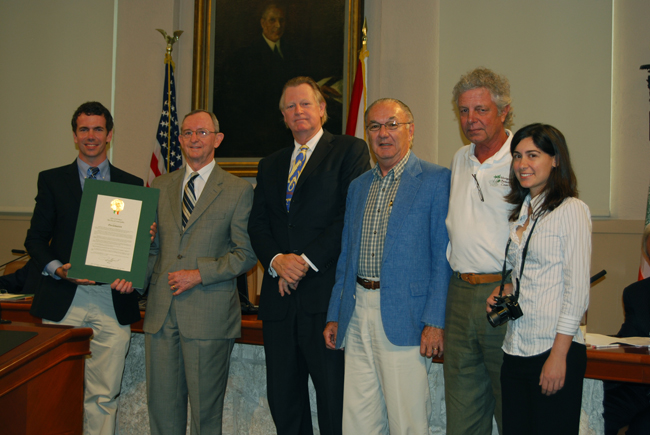
April 29, 2009
Coral
Gables proclaims, “Montgomery Botanical Center Day.”
April
29, 2009 has been proclaimed Montgomery Botanical Center Day in Coral
Gables. The city commission presented a glowing proclamation
highlighting 50 years of accomplishments to the MBC leadership at the April
28 City Commission Meeting. Dr. Patrick Griffith presented a brief
history and summary of MBC’s work to the Mayor and Commission, which
can be downloaded here.
Commissioner Wayne “Chip” Withers recognized the MBC team in
attendance,
including President Charles P. Sacher, Vice President Dr. Karl Smiley,
Executive Director Dr. Patrick Griffith, Superintendent Lee Anderson
and Funding and Communications Manager Tracy Magellan.
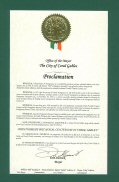
The
proclamation
details MBC’s history and accomplishments, and concludes thus:
NOW,
THEREFORE, I, DONALD D. SLESNICK II, as Mayor of Coral Gables, along
with the members of our City Commission do hereby proudly proclaim,
April 29, 2009 as:
“MONTGOMERY
BOTANICAL CENTER DAY IN CORAL GABLES”
In observance thereof, we congratulate said facility for its
fifty years of involvement in our Coral
Gables and South Florida Community.
Dr.
Patrick Griffith states, “Having the support and recognition of the
City for our important work in botany affirms and strengthens our
mission. We are all very happy to have the Coral Gables leadership
involved in celebrating Montgomery Botanical Center’s 50th anniversary.”
 
April 22, 2009
Fairchild Challenge Team hard at work at MBC
for Earth Day
Six
volunteers from the Education Department at Fairchild Tropical Botanic
Garden came to Montgomery Botanical Center to work on a large cycad
horticulture project. These
Encephalartos collections are important for conservation and
botanical research. These collections were originally dressed
with organic mulch, but are being converted to granite mulch, as MBC
has had good results with this medium. We thank the Fairchild
Challenge Team for all of their hard work on the project.
Dr.
Patrick Griffith, MBC Executive Director, states: "Enthusiasm,
expertise, and most importantly, brawn
-- these are the great qualities that come to mind when I
remember the awesome work of the Fairchild Challenge Team. Working
alongside Junior, Nancy, Netiva, Surey, Marion and Hayes was great fun.
I consider myself a huge fan of the great work being done in education
at FTBG."
April 16, 2009
Gifford
Arboretum Lecture co-sponsored by MBC
Montgomery
Botanical Center was honored to co-sponsor the 21st
Gifford Arboretum Lecture at the University of Miami. Dr. Lucia
Lohmann of the Universisdade de Sao Paulo, Brazil, gave a lecture
titled, “Disentangling one of Darwin’s great mysteries: The story of
climbing plants.” Dr. Lohmann’s work investigates current and past
environmental factors in a phylogenetic framework, answering questions
about the evolution and diversification of climbing plants.
The event also included a commemoration of Charles Darwin’s 200th
birthday -- A 200th birthday cake was served, and an encounter between
Darwin and Sebastian the Ibis was enacted for the assembled guests.
April 15, 2009
Paul
Drummond Fund sponsors fieldwork in Belize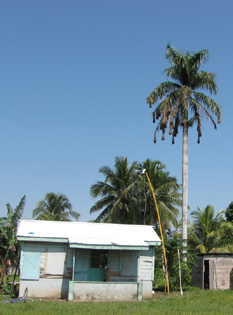
Dr.
Larry Noblick, MBC Palm Biologist, performed conservation and research
fieldwork in Belize during March, working with biologists from Belize Botanic Gardens and Green Hills Botanical
Collections. Belize is known to have a very diverse palm flora,
with an especially large number of genera relative to the geographic
area. Many populations in Belize are of biogeographic significance, as
they represent range limits for species or genera. Of particular
interest for this work was Pseudophoenix,
which reaches its
southwestern limit in one population of Pseudophoenix sargentii in
Northern Belize.
A detailed report
is available on our
Expeditions page.
The Paul Drummond Fund was established at Montgomery Botanical Center
to honor the life and work of Paul Drummond, past president of the
International Palm Society and lifelong palm enthusiast. Paul
Drummond’s legacy of cultivating and sharing palm species remains a
lasting legacy.
April 4, 2009
Palm
Societies Come Together at Montgomery
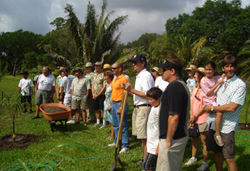 Montgomery
Botanical hosted a joint meeting of the South Florida Palm
Society and the Central Florida
Palm and Cycad Society on April 4 -- over 40 members participated.
The meeting centered on a volunteer effort to plant a population of Roystonea oleracea.
These palms are the direct result of fieldwork in Trinidad
and Tobago in 2007 which was generously funded by the South Florida
Palm Society. Montgomery
Botanical hosted a joint meeting of the South Florida Palm
Society and the Central Florida
Palm and Cycad Society on April 4 -- over 40 members participated.
The meeting centered on a volunteer effort to plant a population of Roystonea oleracea.
These palms are the direct result of fieldwork in Trinidad
and Tobago in 2007 which was generously funded by the South Florida
Palm Society.
Montgomery Botanical Center enjoys a good relationship with both
Palm Societies throughout the state. The South Florida Palm Society,
the Central Florida Palm and Cycad Society, and Montgomery Botanical
Center all have the conservation and appreciation of Palms as central
aspects of their missions.
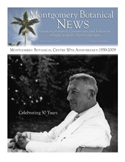
April 2009
Spring
2009 Montgomery Botanical News Available Online
The
newest edition of the Montgomery Botanical News is hot off the
press. This special fiftieth anniversary issue combines history
and current research. Montgomery Botanical Center is celebrating
its fiftieth anniversary in 2009 and this issue is commemorating our
founders and our mission.
To
access PDFs of the newsletters please go to the Newsletters
button.
March 31, 2009
Montgomery
Botanical Center Hosts Students for Environmental
Immersion
Day
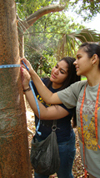 Students
from Mater Academy Charter School
visited
Montgomery
Botanical
Center
this week
as Students
from Mater Academy Charter School
visited
Montgomery
Botanical
Center
this week
as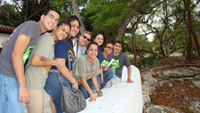 Eight students and their AP
Environmental
Science teacher Natalie
Ledoux
began with a
tour and history of Montgomery
Botanical Center
followed by five rotations. The rotations taught
practical skills
relating to soil and root science, seedbank operations, conservation in
the nursery, tropical
forestry, and cycad biology. It was great
having
so many enthusiastic students participate in our conservation efforts
here at Montgomery Botanical Center. Education and Conservation
are
vital to the long term preservation of threatened palms and cycads.
Eight students and their AP
Environmental
Science teacher Natalie
Ledoux
began with a
tour and history of Montgomery
Botanical Center
followed by five rotations. The rotations taught
practical skills
relating to soil and root science, seedbank operations, conservation in
the nursery, tropical
forestry, and cycad biology. It was great
having
so many enthusiastic students participate in our conservation efforts
here at Montgomery Botanical Center. Education and Conservation
are
vital to the long term preservation of threatened palms and cycads.
March 28, 2009
Montgomery
Botanical Center Hosts 50th Members Meeting
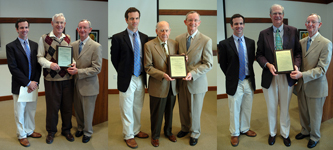 Montgomery Botanical Center had its 50th Members Meeting
this year. Montgomery president Charles P. Sacher presented four
plaques for outstanding service and commitment. Those receiving
awards were Walter Haynes, Loyd Kelly, Stanley Kiem, and John Popenoe. Montgomery Botanical Center had its 50th Members Meeting
this year. Montgomery president Charles P. Sacher presented four
plaques for outstanding service and commitment. Those receiving
awards were Walter Haynes, Loyd Kelly, Stanley Kiem, and John Popenoe.
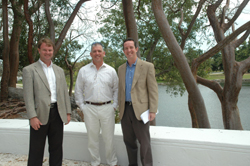
Walter Haynes gave a very well received presentation on the history of
Robert Montgomery, Nell Montgomery, and Montgomery Botanical
Center; It was a retrospective looking back to 1932.
At the meeting, three new directors were elected: Mark Smiley, David
Manz, and Charles S. Sacher (left to right). Please join us in
congratulating their joining the Montgomery team.
March
15, 2009
SFPS Spring 2009 Palm Sale at MBC
The
South Florida Palm Society had their Spring 2009 Sale at Montgomery
Botanical Center this weekend. Vendors had rare palms and cycads,
along with many landscape industry classics, for sale. 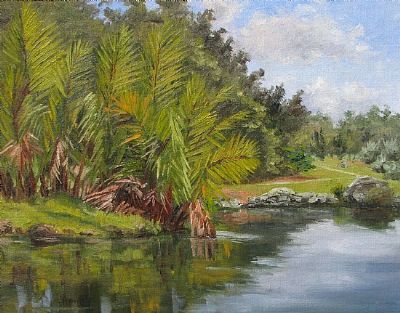
The SFPS palm sale gives MBC the opportunity to educate the community
about our mission and conservation efforts. During the event, MBC
gave guided tours of our 120 acre collection. “It was great to have so
many people come in who share our love of palms,” stated Tracy Magellan.
Considered to be the “World’s Largest Palm Sale,” there were 20 palm
vendors in attendance and one artist, Linda Apriletti. Linda has
many paintings of our palm collection in her portfolio. This
painting shows Nypa fruticans,
which grows in our brackish
ponds.
SFPS has an excellent tradition of supporting conservation efforts and
palm research. The organization has funded a number MBC palm research
expeditions, and also volunteered on landscape projects at MBC.
March 7, 2009
Scientists Convene at Montgomery Botanical
for NSF Cycad and Conifer Research
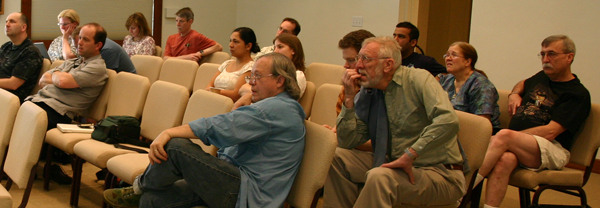
Many
distinguished scientists involved in the Gymnosperms
on the Tree of Life (Gymnosperm AToL) project funded by the
National Science Foundation met at Montgomery Botanical Center (MBC).
These scientists are part of the Assembling the Tree of Life Project,
which has 50 participants from various universities and scientific
research institutions collaborating in an effort to gain insight into
relationships among all life forms.
The group that visited MBC specializes in the evolution and
relationship between non-flowering plants that produce seeds
(gymnosperms). Gymnosperms comprise an ancient lineage of land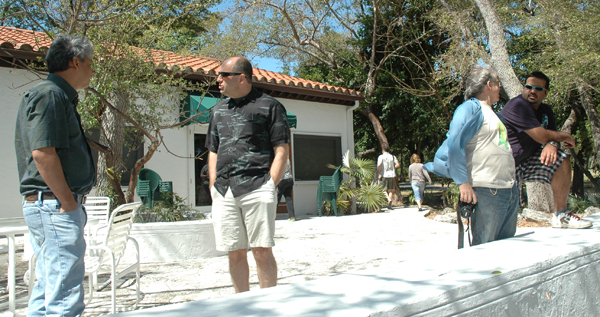 plants, far older than flowering plants. The relationships among
gymnosperms are a critical botanical portion of the AToL project.
The assembled group discussed strategies for processing the large data
sets required, and coordinated their work.
plants, far older than flowering plants. The relationships among
gymnosperms are a critical botanical portion of the AToL project.
The assembled group discussed strategies for processing the large data
sets required, and coordinated their work.
Dennis Stevenson and Damon Little (Montgomery Botanical Research
Fellow), from The New York Botanical Garden, have used MBC’s cycad
collection extensively for their research on the cycad branch of the
Gymnosperm AToL project. Sarah Mathews and her students from the
Arnold Arboretum of Harvard University have used our tropical conifer
collection for their work on the project. MBC has had a long
history of collaboration with NYBG and the Arnold Arboretum. By
providing scientists with access to our collections we are supporting
conservation, research, and education.
Many thanks to Whole Foods
Market in Coral Gables, which generously donated a lovely breakfast
of pastries, fruit, and coffee for the event.
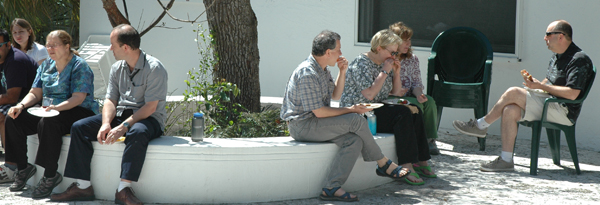
March 7, 2009
Miami Dade College Service Learning Weekend at
Montgomery Botanical Center
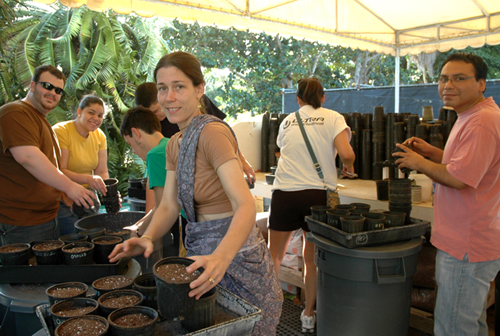
On
Saturday, Lee Anderson and his two long term volunteers Cliff and
Marilynn Renshaw
taught seven of Tracy Magellan's Miami Dade students
how to propagate via cuttings, as part of their course BSC1050-Biology
and the Environment.
Concepts
of root to shoot ratio and plant stress were discussed, and
incorporated into the process.
While
touring MBC, the students were excited to see native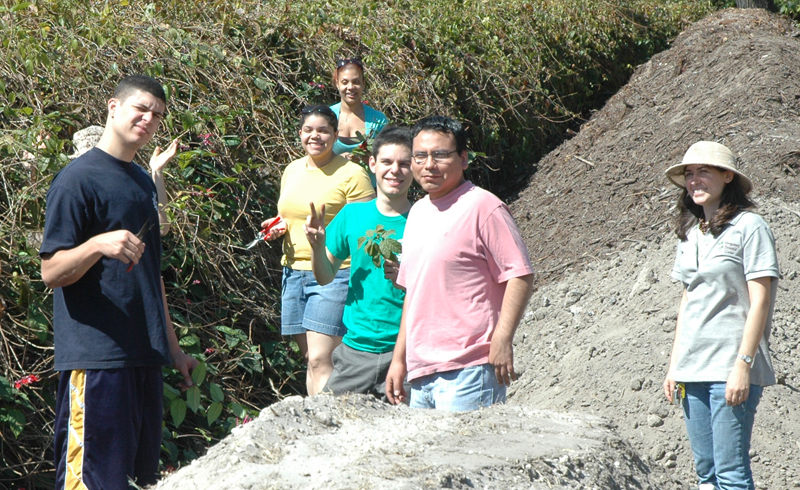 crabs displaying
in their natural habitat (the brackish lakes).
Many students also
commented, they were surprised to discover there was such a large
botanical garden so close to home. crabs displaying
in their natural habitat (the brackish lakes).
Many students also
commented, they were surprised to discover there was such a large
botanical garden so close to home.
MBC
Executive Director Patrick Griffith states, "It's great to see students
participate in horticultural learning projects here; Plant collections
based experience is the best way MBC can enrich student
education."
March 4, 2009
World’s Largest Dicot Seed Arrives at MBC
 MBC
was recently host to a botanical record holder, the giant seed of the
tree Mora oleifera.
This remarkable tree is a semi-mangrove from the Pacific coasts of
Costa Rica, Panama and Colombia. It is a member of the bean
family, Fabaceae, and has never before been cultivated in the United
States. MBC collaborator Richard Moyroud, a plant conservationist
and ecologist in West Palm Beach, coordinated with the Smithsonian
Tropical Research Institute in Panama and MBC to obtain several M. oleifera seeds for enrichment
of US botanical collections. A group of botanists from
neighboring institutions, Drs. Barry Tomlinson, Jack Fisher, Dennis
Stevenson and Jay Horn visited MBC to see this botanical wonder for the
first time. Since MBC already has the palm that produces the
world’s largest seed, the double coconut, Lodoicea maldivica, and
largest-leafed fig, Ficus dammaropsis,
adding the largest dicot seed is a fitting way to expand our collection
of botanical superlatives! MBC
was recently host to a botanical record holder, the giant seed of the
tree Mora oleifera.
This remarkable tree is a semi-mangrove from the Pacific coasts of
Costa Rica, Panama and Colombia. It is a member of the bean
family, Fabaceae, and has never before been cultivated in the United
States. MBC collaborator Richard Moyroud, a plant conservationist
and ecologist in West Palm Beach, coordinated with the Smithsonian
Tropical Research Institute in Panama and MBC to obtain several M. oleifera seeds for enrichment
of US botanical collections. A group of botanists from
neighboring institutions, Drs. Barry Tomlinson, Jack Fisher, Dennis
Stevenson and Jay Horn visited MBC to see this botanical wonder for the
first time. Since MBC already has the palm that produces the
world’s largest seed, the double coconut, Lodoicea maldivica, and
largest-leafed fig, Ficus dammaropsis,
adding the largest dicot seed is a fitting way to expand our collection
of botanical superlatives!
For more information and photos of
Mora oleifera, see the link below:
http://www.mobot.org/MOBOT/research/Edge/oct08/oct08pick.shtml
February 20, 2009
Living
collections research on tropical conifers presented at MBC
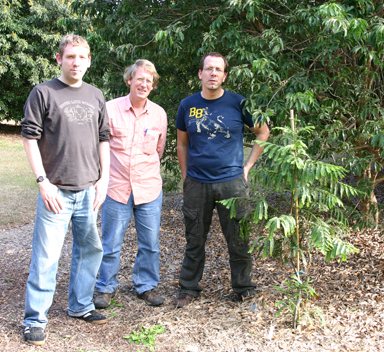
In keeping with Col. Robert
Montgomery’s passion for
conifers, MBC recently hosted botanists
Patrick Knopf and Dr. Christian
Schulz, of Ruhr-University Bochum in Germany in the Arthur
Montgomery
Guesthouse. Mr. Knopf is a Ph.D. student
and Curator of Gymnosperms
at the Institute for Evolution and Biodiversity of Plants. He is
studying the anatomical diversity of the least known conifer family,
Podocarpaceae, as well as the genus Agathis
(Araucariaceae). To carry out his research, Mr. Knopf has
assembled probably the world’s largest living collection of
Podocarpaceae through careful propagation, cultivation and
documentation. The goal of Mr. Knopf’s research is to
develop an anatomical key to the family, so that species can be
identified even when reproductive structures are lacking. In
addition, Mr. Knopf and Dr. Schulz are developing a
molecular phylogeny of
the family that will shed further light on relationships among species
and genera. At MBC Mr. Knopf presented an
overview of his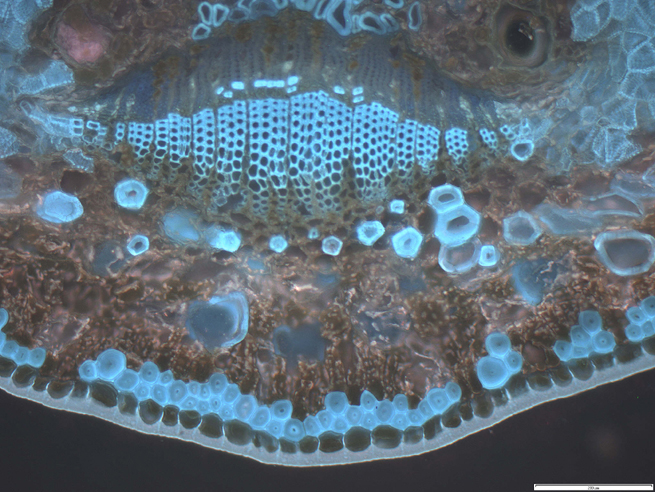 research
and recent fieldwork in the Philippines. Later this year, he will
travel to Fiji, Borneo and Peninsular Malaysia to collect living
Podocarpaceae for his research, which he hopes to curate at MBC. research
and recent fieldwork in the Philippines. Later this year, he will
travel to Fiji, Borneo and Peninsular Malaysia to collect living
Podocarpaceae for his research, which he hopes to curate at MBC.
MBC has been exchanging tropical conifer germplasm with Mr.
Knopf for
several years and this fruitful
partnership continued during this visit. Mr. Knopf went home with
many plants and cuttings from MBC and the Atlanta Botanical Garden
(brought by Conservatory Director Ron Determann, who drove to MBC for Mr.
Knopf’s talk) to
add to his research collection.
Dr. Schulz, a postdoctoral researcher, is also
dedicated to living collections research and has recently studied
cycads at the New York Botanical Garden, but is now focusing on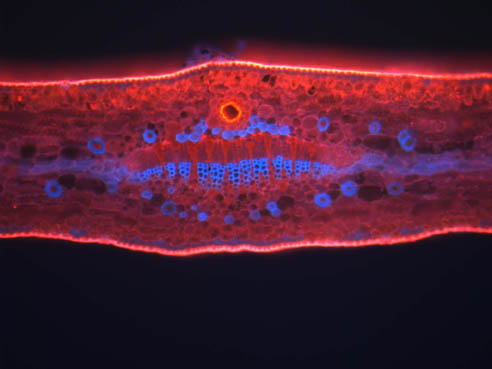 the
genus Selaginella, a very
ancient plant group distantly
related to
ferns. He is establishing a living
collection for his research
and was assisted by MBC
collections manager Chad Husby in locating Selaginella species in South
Florida for his
research. the
genus Selaginella, a very
ancient plant group distantly
related to
ferns. He is establishing a living
collection for his research
and was assisted by MBC
collections manager Chad Husby in locating Selaginella species in South
Florida for his
research.
For an example of Mr. Knopf and Dr. Schulz's collaborative work
in plant
systematics, see the following online interactive key to the conifer
family Cupressaceae.
Montgomery Botanical Center focuses on scientific
living collections and collaborative partnerships. Exchanging
material with other scientists and curators is an important
way of enriching the resources available for botanical research both at
MBC and around the world.
January 12, 2009
The Villagers Generously Grant Funds for
MBC Guesthouse Restoration
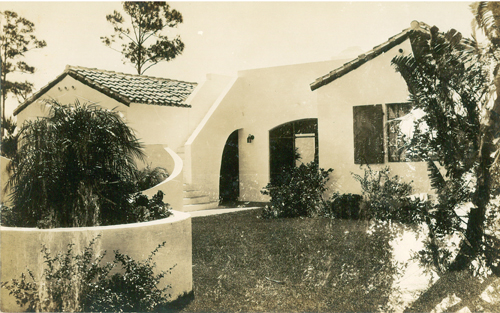 The Villagers have
generously funded various restoration projects for Montgomery Botanical
Center's 1930s buildings. The latest grant will help restore the
walls of the Arthur Montgomery Guest House. The Villagers have
generously funded various restoration projects for Montgomery Botanical
Center's 1930s buildings. The latest grant will help restore the
walls of the Arthur Montgomery Guest House.
Designed by architect Robert Fitch Smith and completed circa 1934, the
Arthur Montgomery Guesthouse is an important structure at MBC. Notable
biologists have visited the guesthouse from as early as the 1930s, and
this continues to the present day.
Dr. Arthur Montgomery, the youngest of Colonel Robert Montgomery's
sons, was one of the original 1959 incorporators of Montgomery
Botanical Center. He was a noted mineralogist who founded what is now
the Montgomery Botanical Fellows Program, which is continued through
the Kelly Foundation. The Guesthouse was formally named the Arthur
Montgomery Guesthouse in March 1992.
Dr. Patrick Griffith states, "Hosting visiting researchers who study
our collections is one of the most important things we do at MBC.
Support from The Villagers ensures that the Arthur Montgomery
Guesthouse can continue to serve botanical science."
January 2009
Montgomery Botanical Center Celebrates 50
Years
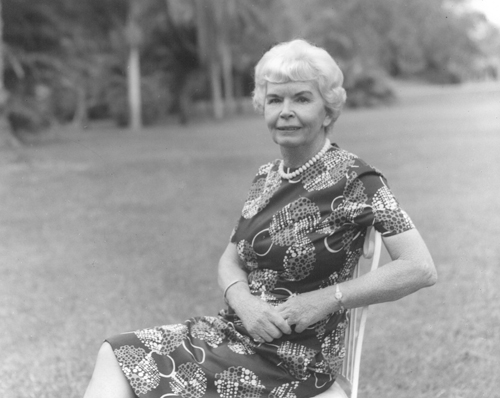
In
1959, Montgomery Botanical
Center was established as the Montgomery
Foundation by Nell Montgomery Jennings in memory
of her husband Colonel
Robert Montgomery and his love for palms. The
buildings and plant
collections date to 1932, when Robert built the Coconut Grove
Palmetum,
which now serves as the
infrastructure for Montgomery Botanical Center.
For 50 years Montgomery Botanical
Center has been advancing
conservation, research, and education in many ways. Since 1959, numerous expeditions
have been conducted to locations worldwide, bringing many new palm
and
cycad species into cultivation. These activities have greatly accelerated in recent years:
since 1990, MBC has conducted over 70
research and collecting expeditions, and supported
12 Research Fellows
from countries around the world.
MBC’s Arthur Montgomery Guesthouse has
hosted plant scientists from over 50 countries, while they study the
living plant collections.
For details
of MBC’s early and recent
history, please visit the History
Page, browse our Newsletters,
and
also see our News
Archives.
Rigorous curation and strong ethics
in MBC’s collecting practice have
been recognized. The MBC palm
collection and cycad
collection were
recently accredited by the NAPCC.
Looking forward, MBC expects further
advancement of botanical research and conservation.
MBC
News Archive
2005 2006 2007 2008 2009 2010 2011 2012 2013 2014 2015 2016
|



